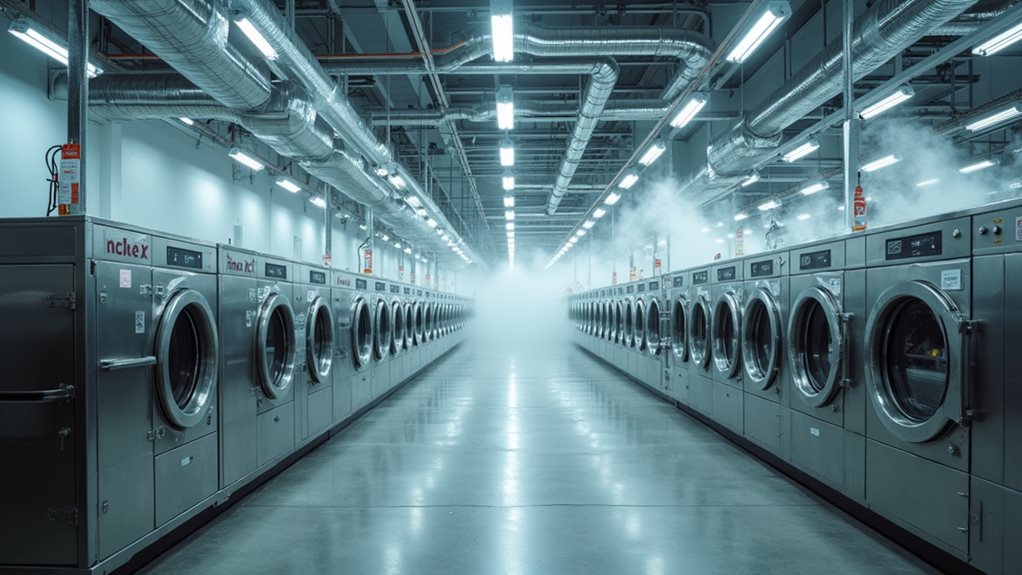You’re looking at a surprisingly resilient $60.88 billion global industry that’s weathered notable storms, from pandemic shutdowns to the casual Friday revolution that turned every day into sweatpants day. While the U.S. market represents roughly $9-12 billion of that total, the industry’s seen establishments drop from 27,204 to just 16,497 over two decades, yet it’s still employing around 105,000 people who keep our formal wear looking sharp when life demands we dress up again. The numbers tell a fascinating story of adaptation.
Current Market Size and Revenue Projections
When I first started paying attention to business numbers, the dry cleaning industry’s $60.88 billion global market size honestly surprised me—it’s one of those sectors you don’t think much about until you’re standing there with a coffee-stained blazer, desperately needing help before tomorrow’s big meeting.
Here’s what’s fascinating about these revenue projections: while the dry cleaning industry faced a rough patch with a 2.6% decline over five years (thanks, pandemic and casual Friday culture), it’s showing signs of resilience.
You’ll see a 1% growth rate expected for 2024, and cleaning services are projected to hit $9.4 billion by 2025. The future looks brighter too, with analysts predicting the market could reach $149.1 billion by 2035.
The U.S. market alone accounts for approximately $9-12 billion of the global total, driven by factors like increasing urbanization and busy lifestyles that create greater demand for professional garment care services.
Historical Growth Patterns and Performance Trends
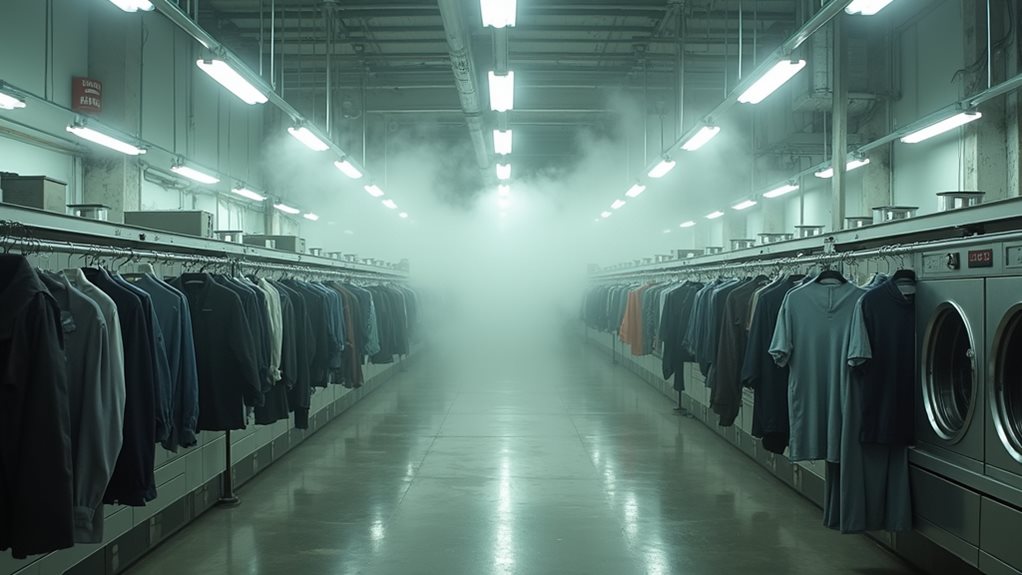
Looking back at those revenue numbers makes me think about my grandfather’s dry cleaning business, which he ran from 1975 until he sold it in 2008—right at what turned out to be a perfect time, though he couldn’t have known the industry was about to face its biggest challenges in decades.
Sometimes the best business decisions are the ones you make without knowing what’s coming around the corner.
The historical data tells a sobering story about how dramatically consumer habits can reshape entire industries, and honestly, it’s fascinating to watch these industry performance trends unfold:
- Establishment decline: From 27,204 locations in 2001 to just 16,497 by 2022
- Recent contraction: -2.6% CAGR over the past five years
- Revenue growth hope: Projected $9.5 billion by 2025
- Consumer shift: Remote work reducing demand for professional garments
The dry cleaning industry’s historical patterns show resilience despite these headwinds. Despite ongoing challenges, the global market remains substantial at approximately $90-100 billion annually, demonstrating the enduring need for professional garment care services worldwide.
Key Market Segments and Service Categories
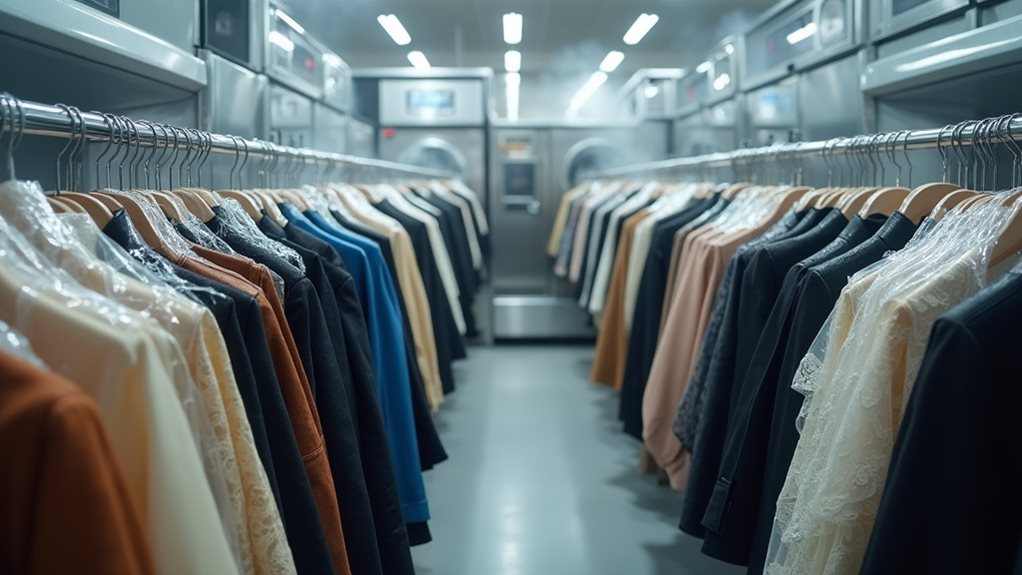
When you’re looking at the dry cleaning industry’s structure, you’ll find it’s fundamentally split between two main customer bases: residential clients who need their wedding dresses and work suits expertly cleaned, and commercial accounts like hotels that require massive volumes of linens processed daily.
The residential segment dominates with about 65% of total demand, which honestly makes sense since we’ve all had that moment of panic when coffee spills on our favorite shirt right before an important meeting 😅.
Meanwhile, the commercial side captures roughly 35% of the market, focusing on specialized services for hospitals, hotels, and businesses that need consistent, high-volume cleaning solutions with strict hygiene requirements.
Beyond traditional storefronts, the industry has expanded to include pickup/delivery services that cater to busy professionals who value convenience over visiting physical locations.
Commercial Vs Residential Markets
Two distinct customer bases shape the dry cleaning environment, and understanding their differences can help you grasp where this industry’s headed.
When I first started analyzing market trends, I was surprised by how differently these segments behave and what drives their spending decisions.
Here’s how these markets break down:
- Residential consumption dominates at 65% of total demand, driven by busy professionals wanting convenience and post-COVID hygiene standards.
- Commercial applications represent 35% but grow faster at 6.8% annually, fueled by expanding tourism and healthcare sectors.
- Laundry services segment captures 60-65% of industry share, while dry cleaning services hold 35-40%.
- Premium garment care shows steady growth as consumers invest in quality clothing requiring specialized attention.
Commercial clients typically offer consistent, higher-volume contracts, while residential customers provide steady, relationship-based revenue streams. The rise of eco-friendly cleaning solutions has become a significant market driver as both segments increasingly prioritize environmentally conscious service options.
Service Type Breakdown
Breaking down the service types within dry cleaning reveals a surprisingly diverse ecosystem that I never fully appreciated until I started tracking customer patterns across different business models.
You’ll find that traditional dry cleaning services still dominate the market size, but eco-friendly practices are reshaping everything from solvents to customer expectations.
Commercial dry cleaning remains the heavyweight champion, serving hotels and hospitals with consistent volume, while residential services are evolving rapidly.
The real game-changer? Pickup and delivery services that cater to time-starved professionals who’d rather spend weekends hiking than hunting for parking at the cleaners 😊.
This shift toward convenience-based offerings shows how the industry adapts to changing lifestyles, proving that even century-old businesses can innovate.
With approximately 28,000 to 30,000 dry cleaning establishments operating nationwide, this diverse service landscape generates billions in annual revenue while serving millions of customers across different market segments.
Geographic Distribution and Regional Analysis
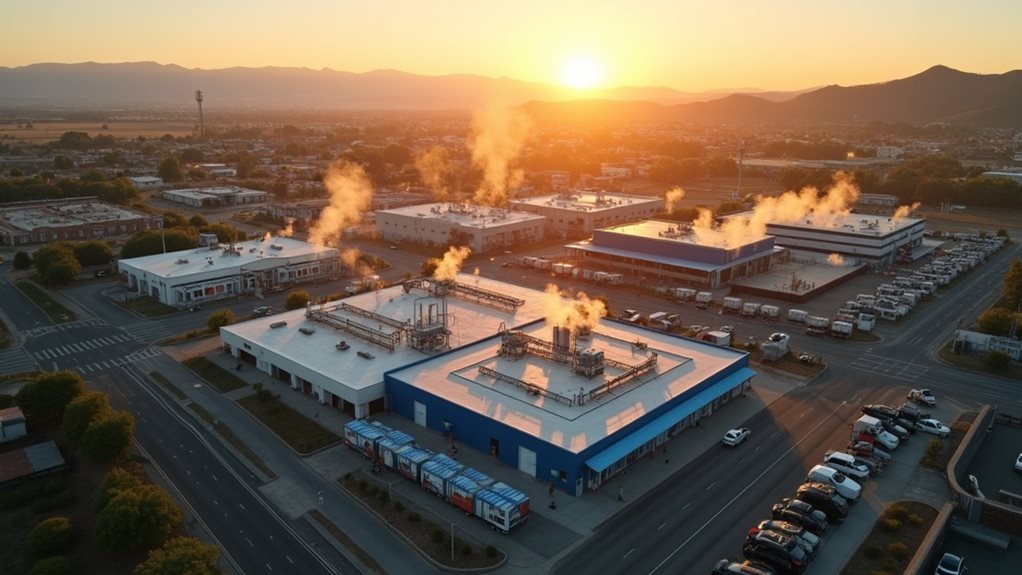
Although I’ve spent countless hours driving through different neighborhoods while researching this industry, what struck me most wasn’t the fancy storefronts or clever signage, but rather the stark geographical reality that’s reshaping where you’ll actually find dry cleaning services today.
The dry cleaning industry has experienced dramatic geographic distribution shifts, with establishments plummeting from 27,204 to 16,497 between 2001-2022.
Here’s what you need to understand:
- Urban centers dominate the setting, clustering where population density meets professional consumer demand
- Metropolitan areas with formal-wear employment drive service concentration
- Environmental regulations are forcing strategic relocations and adaptations
- Rural and suburban areas face increasing service gaps as businesses consolidate
This $9.4 billion industry’s geographic footprint continues shrinking, even as urban markets remain relatively stable 📍
States like California, New York, and Texas lead in total establishments due to their large populations and concentration of business-heavy metropolitan areas.
Major Industry Players and Market Share
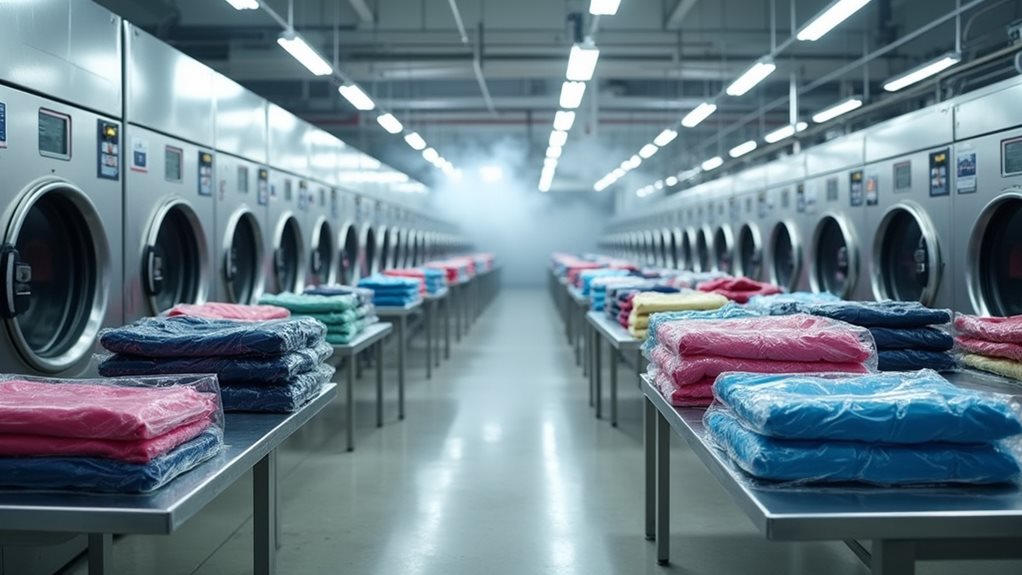
When you’re trying to understand just how massive this industry really is, you’ll want to look at who’s actually running the show and how they’ve carved up this multi-billion dollar pie among themselves.
The dry cleaning world isn’t dominated by just one giant corporation like you might expect – instead, it’s a fascinating mix of established machinery manufacturers like Alliance Laundry Systems, innovative tech-forward companies like Rinse that are basically the Uber of laundry, and even household names like Tide jumping into the brick-and-mortar game.
I remember being genuinely surprised 😅 when I first discovered that the company behind my favorite laundry detergent was also competing for my dry cleaning dollars, but that’s exactly the kind of competitive environment that makes this industry so dynamic and worth billions.
What makes this competition even more intense is that successful dry cleaning operations can achieve profit margins between 15-25% annually, attracting both established players and new entrepreneurs to fight for market share.
Leading Company Profiles
Four major players dominate the dry cleaning scene, and honestly, understanding their strategies might surprise you more than finding that mysterious stain on your favorite shirt.
These leading company profiles reveal how the dry cleaning industry has evolved beyond traditional storefronts into tech-savvy, environmentally conscious businesses that actually care about your convenience.
- Alliance Laundry Systems – Controls 10-13% market share by supplying commercial machinery globally, basically powering the equipment that cleans your clothes behind the scenes.
- Tide Cleaners – Procter & Gamble’s franchised chain holds 8-11% market share, combining eco-friendly practices with app-enabled services that’ll make you wonder why you ever waited in line.
- Rinse, Inc – Revolutionizes pickup/delivery through AI-driven logistics and sustainability commitments.
- ZIPS Dry Cleaners – Disrupts pricing with flat-rate models emphasizing speed and affordability.
These companies maintain their competitive edge by focusing on quality service and operational efficiency, which allows them to achieve the industry-standard profit margins that make their businesses sustainable.
Market Share Distribution
Twenty-three percent of the entire dry cleaning industry belongs to just these four companies, which means the remaining 77% gets split among thousands of smaller players who’re probably cleaning your neighborhood’s clothes right now.
Alliance Laundry Systems commands the largest market share at 10-13%, focusing on commercial machinery that powers countless operations. Tide Dry Cleaners follows with 8-11%, leveraging P&G’s brand recognition and eco-friendly innovations that you’ve likely noticed.
ZIPS disrupts traditional pricing with their flat-rate model, while Rinse capitalizes on our app-obsessed culture with AI-driven logistics.
This distribution reveals something fascinating: despite massive growth and increasing demand, the dry cleaning market remains beautifully fragmented, giving local companies real opportunities to thrive alongside these industry giants. These smaller operations typically achieve profit margins of 15% to 25% on their annual revenue, making the fragmented nature of the industry particularly attractive for independent entrepreneurs.
Competitive Landscape Analysis
Looking beyond just market share percentages, you’ll discover that the competitive dynamics within dry cleaning reveal fascinating strategies that mirror broader retail evolution happening across America.
The dry cleaning industry’s $9.5 billion market size creates room for diverse approaches, and honestly, it’s invigorating to see traditional businesses adapting so creatively.
Here’s how major players are reshaping this competitive terrain:
- Alliance Laundry Systems dominates with 10-13% market share through equipment innovation.
- Tide Dry Cleaners captures 8-11% by leveraging brand recognition from household products.
- Rinse, Inc. revolutionizes convenience with AI-driven pickup and delivery services.
- ZIPS Dry Cleaners disrupts pricing with flat-rate models that eliminate guesswork.
These strategies show you’re witnessing an industry transformation where technology meets tradition, creating opportunities for both established giants and nimble newcomers. For entrepreneurs considering entering this market, startup costs typically range from $200,000 to $500,000, reflecting the substantial investment required to compete effectively.
Employment Statistics and Business Count
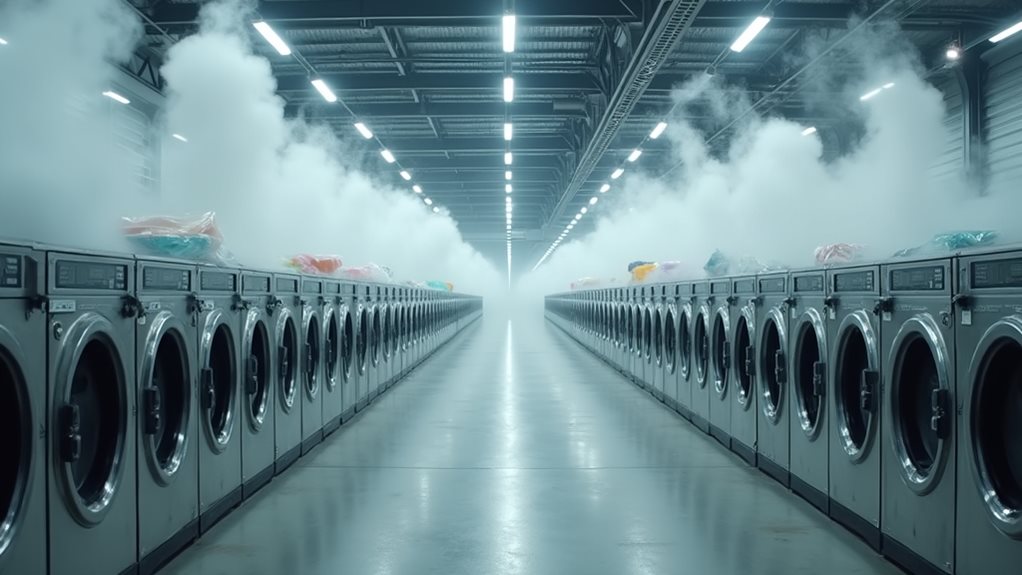
When you’re curious about the actual size of the dry cleaning workforce, the numbers tell a fascinating story that’s both surprising and revealing about this essential service industry.
The employment statistics show approximately 105,000 individuals working across dry cleaning businesses throughout the United States, though you’ll notice some conflicting data suggesting around 5,054 workers specifically in core dry cleaning roles.
What’s particularly interesting is the workforce composition – you’re looking at 71.5% women with an average age of 48 years, which speaks to the industry’s experienced, dedicated professionals.
The business environment includes roughly 25,775 establishments, yet industry statistics reveal a concerning trend: locations dropped from 27,204 in 2001 to just 16,497 by 2022, showing notable consolidation despite steady demand.
Financial Performance and Profitability Metrics

Although the dry cleaning industry might seem like a steady, recession-proof business from the outside, the financial reality tells a more complex story that’s worth understanding if you’re considering entering this field or simply curious about its economic health.
The dry cleaning industry’s profitability terrain reveals some eye-opening patterns that’ll help you grasp where the money really flows:
- Revenue projections show modest decline – from $9.5 billion in 2024 to approximately $9.4 billion by 2025.
- Service pricing ranges dramatically – you’ll pay anywhere from $6.50 to $20 per garment depending on complexity.
- Business operations favor scale – larger companies consistently outperform smaller competitors in profit margins.
- Commercial garment services drive higher profitability than residential customers alone.
This 2.6% annual decline reflects changing consumer habits, making strategic positioning vital for sustainable business operations.
Future Outlook and Growth Forecasts
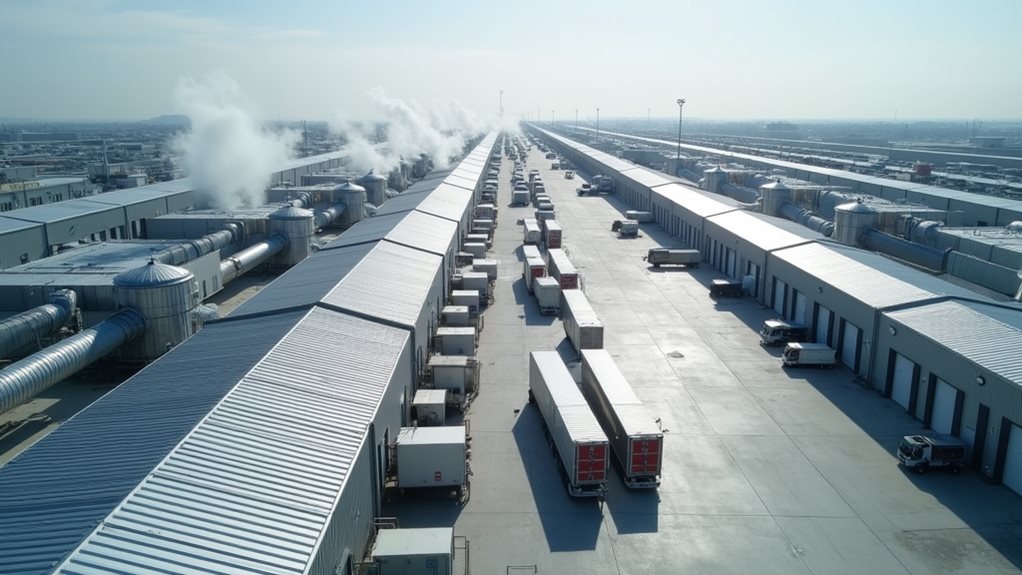
Despite the recent modest declines we’ve discussed, the dry cleaning industry’s future actually paints a surprisingly bright picture that might change how you think about this traditional business.
Growth forecasts show the services industry expected to grow from $83.2 billion in 2025 to $149.1 billion by 2035, which honestly surprised me when I first saw those numbers 📈.
The demand for laundry services is being fueled by urbanization and dual-income households who, like my own busy neighbors, simply don’t have time for garment care anymore.
You’ll find that premium services, especially same-day pickup, are becoming the real goldmine, while the dry cleaning industry itself maintains a steady 6% CAGR that’s actually quite impressive for such a mature market.

